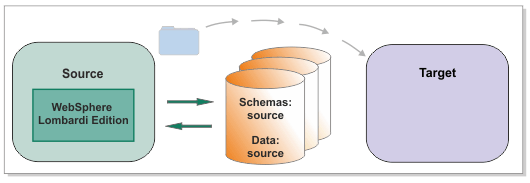Migrate the configuration
information from your source environment so that you can start with
the same configuration when you create your target environment. Later,
you will use the IBM BPM Configuration editor to configure the environment
that you want.
Figure 1. Sample environment after V8.5.5 is installed
on the target and BPMConfig -migrate is run. The output folder is
being copied to the target environment. The source environment is
running and transferring data to and from its databases. The target
has been created but does not contain a deployment environment.
Before you begin
If the source
environment is a network deployment environment, ensure that the deployment
manager, nodes, and deployment environment have been started. If the
source environment is a stand-alone environment, ensure that the stand-alone
server has been started.
About this task
Run the BPMConfig -migrate command
to export the configuration information from the source environment
and generate the properties file. You will later configure your new
environment with the IBM BPM Configuration editor. The changes that
you make in the editor are saved to the properties file and used to
create the target environment that you want.
Procedure
- If you modified the 100Custom.xml file
for Process Server or Performance Data Warehouse, make sure that the 100Custom.xml files
on the managed node are in sync with the 100Custom.xml files
on the deployment manager. If not, manually copy the 100Custom.xml files
from the node profile to the deployment manager profile.
You must perform this step because the BPMConfig
-migrate command reads the 100Custom.xml file
from the deployment manager profile only. The command exports the 100Custom.xml files
for Process Server and Performance Data Warehouse from the deployment
manager profile to the snapshot folder.
All customized .xml files
in the /config folder are merged, and PDW_100SourceCustomMerged.xml and ProcessServer_100SourceCustomMerged.xml files
are created in the output directory that you chose. The XML files
are merged in a sequence where those starting with a letter of the
alphabet are merged before those that start with numbers, which are
merged in numeric order. For more information about which files are
merged and the sequence that is used, see the comments in 100SourceCustomMerged.xml.
If
you modified any configuration files under the /config/system folder,
such as 99Local.xml or 00Static.xml,
directly on the source environment, the customization in these files
will not be migrated, and you must apply the same customization to
the target at post migration.
- Migrate the configuration information
from your source environment and generate the properties file.
- If you installed the new version of the product on the same computer
as the source environment, run the following command in the target
environment:
BPM_home_8.5/bin/BPMConfig -migrate -wasHome source_installation_directory -profile profile_name -outputDir path_to_configuration_folder
- If you installed the new version of the product on a different
computer and copied the migration files to the source environment,
run the following command in the source environment on the computer
where the deployment manager or stand-alone server is deployed:
remote_migration_utility/bin/BPMConfig -migrate -wasHome source_installation_directory -profile profile_name -outputDir path_to_configuration_folder
where:- source_installation_directory is the full path
to the previous installation in the source environment.
- profile_name is the name of the stand-alone
profile.
- path_to_configuration_folder is the full path
to the folder where you want to put the configuration files.
For example:
BPMConfig.sh -migrate -wasHome /opt/Lombardi72/AppServer/ -profile server01 -outputDir /home/user_name/72configuration
Logging to file path_to_log_file.
Initializing context for export...
Input the source process server cluster name: twprocsvr_cluster
Input the source performance data warehouse cluster name: twperfsvr_cluster
You are using BPMConfig to migrate from product version to IBM BPM 8.5.7.0.
Choose the deployment environment type for the target environment:
1. Standard
2. Advanced
Input option number: 1
Choose the topology for the target environment:
1. Single Cluster
2. Three Clusters
Input option number: 2
Input the node number for the target environment: 1
Exporting security information...
Exporting data source information...
Exporting WebSphere Lombardi XML information...
Exporting performance tuning parameters...
The command completed successfully.
- Copy the output folder to the target environment. The output folder contains files similar to the
following files:
Table 1. Files for migration| Sample name |
Description |
|---|
| DE1-Standard-PC-ThreeClusters-DB2.properties |
The properties file containing the configuration
information from your source environment. You will use this file when
you configure the target environment. You can see a list of the properties
in the Configuration properties for the BPMConfig command topic. |
| ldap_additional_properties.xml |
If you use a federated repository and an unencrypted
LDAP connection in the source environment, additional properties of
the LDAP server are copied from the source environment to be migrated
to the target environment. |
| PDW_100SourceCustomMerged.xml and
ProcessServer_100SourceCustomMerged.xml |
If you have XML configuration properties files,
they are copied from the source environment to be migrated to the
target environment. |
Note: In the properties file that contains
the configuration information from your source environment, look for
endpoint information that contains the load balancer information from
the source configuration. Make sure that the host name and ports will
be reused for the target environment. For example, if a web server
or a load balancer is configured in the source environment, you will
see the following lines in the properties file:
bpm.de.processServer.processAdminPrefix=http://webserver.austin.ibm.com:80/ProcessAdm
bpm.de.processServer.teamworksWebAppPrefix=http://http://webserver.austin.ibm.com:80/teamworks
bpm.de.processServer.defaultNamespaceUri=http://http://webserver.austin.ibm.com:80/schema/
bpm.de.processServer.commonPortalPrefix=http://http://webserver.austin.ibm.com:80/portal
If
you are using a different web server for the target environment, modify
the host name and ports in these lines. The migration code does not
use the changes made directly in the
99local.xml file. If you have not used the
100custom.xml
file to override the default values, you will not see the these lines
in the properties file and you can configure the endpoints after the
target environment is configured. See
Customizing IBM BPM to work with
a web server.
Note: - Some XML security configuration properties are moved
to the WebSphere® Application
Server configuration
files automatically. These properties are exported to the properties
file and will be moved to the WebSphere Application
Server configuration
files when you run
BPMConfig -create. Refer to Security configuration properties for a list of the properties
that have been moved.
